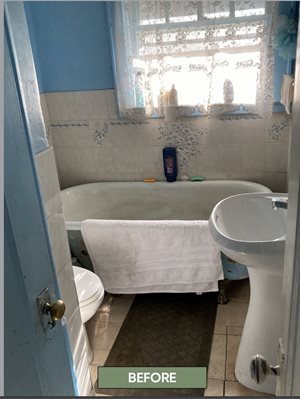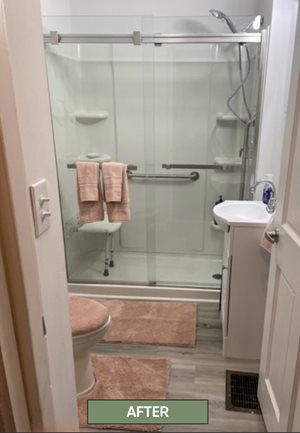Nana Asantewa has lived in the same house in Louisville, Kentucky, for more than 50 years. But recently, edema hindered her mobility, especially when navigating her clawfoot bathtub.
"You don't know how important a bath is until you can't take one,"she says. She reached out to New Directions, a NeighborWorks network organization with programs to help residents age in place. The organization exchanged the tub for a walk-in shower with a seat, moved her high-rise toilet and installed new floors and an automatic light to help prevent falls. Next up: a wheelchair ramp.
 Asantewa, 80 and on a fixed income, had a career in social services and wasn't used to asking for help. "They were a blessing to me,"she says. "I feel good in my home."
Asantewa, 80 and on a fixed income, had a career in social services and wasn't used to asking for help. "They were a blessing to me,"she says. "I feel good in my home."
With projects ranging from yardwork to bathroom remodels, New Directions' repair program helps over 225 homeowners a year, shares Max Monahan, director of Home Ownership Preservation. "But we get 400 applications a year, so despite our success, there's still a great need."
Romi Hall, NeighborWorks America's director of Healthy Homes and Communities, says, the need for aging in place is great throughout affordable housing and community development, especially as people live longer. "Supporting older adults to age in their homes helps to reduce isolation, create stability and ensures residents can be safe in their homes. These programs are important not just to the individual, but to the larger community."According to the U.S. Census, more than 16% of the U.S. population is 65 and older.
"We believe aging in place is the future, especially for low-income homeowners,"says Monahan. Along with the affordability component, ”these are the homes where they've worked and lived their whole lives. They are the matriarchs and patriarchs of their neighborhoods and they don't want to leave.”
Recently, New Directions partneredwith Spalding University's Auerbach School of Occupational Therapy, having doctoral students accompany construction managers to conduct fall-risk assessments and evaluate activities of daily living.
Sara Story, chair and associate professor for Spalding's OT program, says her students had worked with New Directions for nearly 10 years, volunteering at the Repair Fair and more, when she and Monahan began discussing a potential partnership in light of the "silver tsunami"of aging Baby Boomers. According to AARP, 90% of Americans over age 65 want to stay in their homes as long as possible. When the university added a capstone component for its doctoral program, the solution was born.
with New Directions for nearly 10 years, volunteering at the Repair Fair and more, when she and Monahan began discussing a potential partnership in light of the "silver tsunami"of aging Baby Boomers. According to AARP, 90% of Americans over age 65 want to stay in their homes as long as possible. When the university added a capstone component for its doctoral program, the solution was born.
"We needed to look at the next step, of how having a sense of community can help one age in place successfully,"Story says. "Aging in place and productive aging are really important to me as a therapist and human being. And I had so many students who wanted to do this."
Kaelyn Broell was one of the first students to work on the project and set up the protocols. While she'd done clinical fieldwork, "this was the first opportunity I had with how occupational therapy can work on a grander scheme,"she says. "My work also opened the door to demonstrate the growing needs of the aging community and how providing home modifications can positively influence the healthcare outcomes for this population." She hopes the conversation about aging in place will keep growing.
It has at New Directions where George Sanders, chief impact officer, says staff members are also working on a strategy for multifamily properties with an eye on technology, including for fall detection. At existing senior apartments, New Directions will employ "wearables,"devices that connect to emergency teams if a person falls. Plans for an under-construction complex include smart appliances with automatic shutoffs. While it will be some time before they have data, Sanders feels certain they are heading in the right direction.
"It's clear that the cost to society and the cost to the individual are much higher if we don't take proactive steps to assist individuals in being able to age in place,"Sanders says.
For organizations interesting in starting a program, Monahan's advice centers on staff and partnerships: Find someone with occupational therapy expertise, he says, and employ quality contractors and a good construction manager.
05/17/2022

